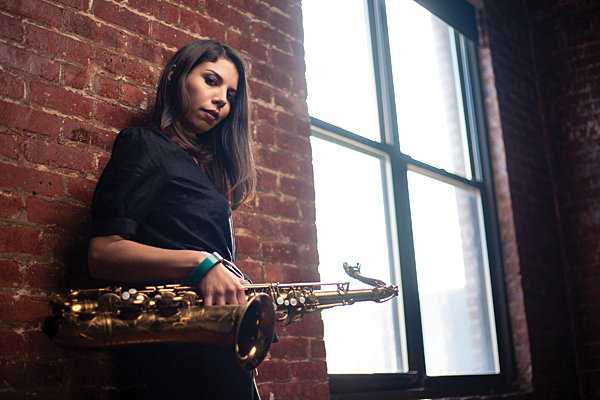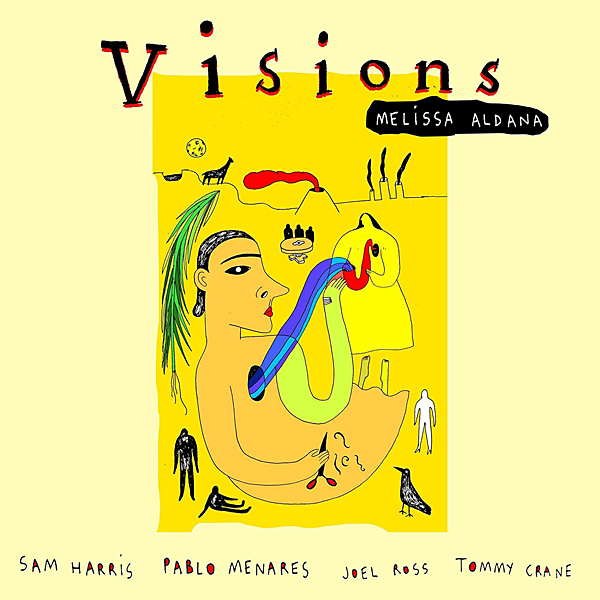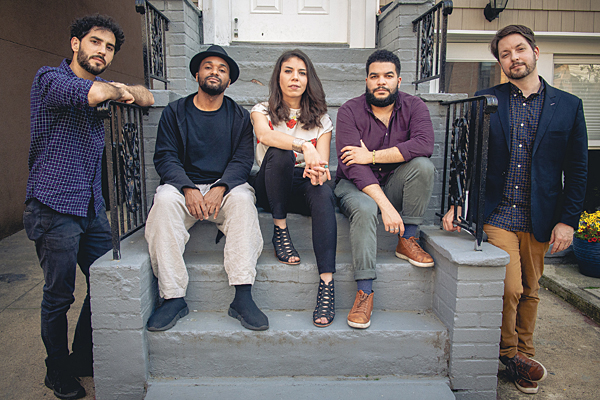| Columns Retired Columns & Blogs |
This interview is an object lesson in how a journalist, entering an interview fully prepared, uncovers layers of information and meaning with each question. Thank you, Ken.
Aldana: I've put a lot of thought into how to have a huge sound but not play loudly. Have a big sound that goes through everything without being loud. How can I have a huge sound but not play loudly? Have a huge sound, or a very big sound, very fat sound, but without having to be loud. The idea of having a good sound, for me, is how the sound goes around everything. I'm aware of how dynamics can create a certain forward motion. If I play softer, if I play louder, if I play time a certain way—everything is going to add a little bit to the story I'm trying to tell, and I can be more articulate.
Micallef: You've transcribed Sonny Rollins, Charlie Parker, Don Byas, Michael Brecker, Mark Turner, and many others. What did that teach you?
Aldana: It taught me about what it means to have a good sound and a good time feel. What it means to play with language. This is interesting to me because now, as a teacher, I see one of the issues with younger generations, the idea of transcribing. We all want to be ourselves, that is a bigger goal, but that's not something that you practice; it's something rather that, with knowledge and time, you allow yourself to become. All musicians are original at the end of the day because we're all different and have different ears. Transcription is a way to understand who I am through someone else's way of expressing themselves.

Micallef: Your father was your teacher.
Aldana: Yes, my dad would sit with me for hours every day. I was very lucky to have my dad who would sit down with me hours a day. We would spend hours and play just like one note, going so deep into the details, how to start the phrase, how to sing the phrase, all the things like going a little bit beyond and all the things that nobody can teach because we just learn by listening so deeply that then it makes sense to you. I have to hear it, have to see it. My process, which has always been like that, transcribing a concept until it gets into my head.
Micallef: You're a big fan of Don Byas.
Aldana: Don—the way that he played harmony—is so hip for the time. I use a lot of leading notes; that comes from a recording of Don Byas playing "Stardust." He started the tune bending notes, and I was like, "Oh my God, I really want to learn this." So all my note-bending comes from listening to Don Byas playing ballads. I hear a direct influence of Don Byas on Benny Golson, who had a strong influence on me, too. It's just a way of playing the horn.
This is my theory: The way that we are all playing the saxophone today ... goes back to the beginning, to a more vertical way of playing. When I hear Mark Turner, the context is much different, and the way he's expressing himself is different, but I can hear the history in his playing. Of course, we have Sonny, Coltrane, Charlie Parker, Kurt Rosenwinkel, Art Tatum, Joe Henderson, Paul Gonsalves, and so many others, but understanding the history is deeper. I've done a lot of deep investigation, in places that people maybe never cared to investigate, to find the balance between the old and the new and what that means to me. When I started analyzing, I found that everything is really connected. The way that the players are outlining harmony, the idea of voice-leading, how you move from one chord change to the next one. It just takes maturity and time and really wanting to go deeper in order to learn more.
Micallef: Do you like Lucky Thompson?
Aldana: I love him. I just never got as deeply into him as I did with Don Byas, but it's definitely an influence. I never really analyzed him, but during the pandemic, I was like, "I need to analyze this," because I like trying to find the balance between the old and the new, and what that is to me. (footnote 1)
Micallef: How many hours a day do you practice?
Aldana: Between four and six. You have your work, and you dedicate your time. I'm happy that my work is something I really love. And the other thing is that I always had a dream to have a band that I could take everywhere and just play with the same guys and grow from that experience. I feel I'm able to have that experience now, and practicing helps me to take advantage of that experience.

Micallef: You've said one of the songs on 12 Stars, "Emilia," was taken from a dream.
Aldana: I have a lot of crazy dreams, but never with melodies. I had this dream that I have a daughter, Emilia. I've had this dream many times. I always hear a melody in this dream about Emilia. One day, after waking, I remembered it.
Micallef: Do the other songs on the album have meanings?
Aldana: For another song, I wanted to write something that would describe the feeling of March 2020. "Intuition" has to do with that moment when I started a journal at the start of the pandemic. I wrote everything that happened. And then I started grabbing that tune. I wrote it in 30 minutes. "The Bluest Eye" was named after the Toni Morrison book. In the book, a poor African-American girl who grapples with depression has this idea that to be beautiful, she must have blue eyes. That resonated with me. Coming from the lower middle class in Santiago, I went to a normal public high school and grew up feeling lower middle class. Other people had more money, and that made a strong impression on me. My classmates and I would often wear blue contact lenses. I never really thought about this until I read this book and thought, "Wow, this is very interesting."
Micallef: What's in your home hi-fi?

Aldana: I use a portable JBL speaker with Bluetooth. The JBL is a pocket speaker. When we're on tour, we do a lot of blindfold tests. So that's why I bought the JBL. It's very small; like the palm of my hand. I haven't had time to set anything up or buy anything, but I also have some older Bose speakers. I think that it's time for me to get it together and get a nice system.
Micallef: 12 Stars was recorded live as a band in studio, yes?
Aldana: Yes. I'm a big believer in what's recorded is what it is, so most of the tracks are live first takes.
Micallef: What is the origin of your Instagram posts?
Aldana: You are hearing the end of my practice. During the pandemic, I felt overwhelmed. It's not part of my personality to do certain things, but as a generational thing, as a musician, I understand that social media is important. But I try to be thoughtful about what I am sharing. I think about practicing in terms of sound, time, feel, and creativity, whatever that is. I'm constantly remembering standards I know or learning a new standard and then working on just creativity—ideas of things I like based on relationships to what I was practicing before with harmony. Once I learn something, I go through a lot of different versions, working on the harmony. Then I put the camera on and record it and post it. It's a way for me to share what I'm practicing, what I'm learning. It's the same when I post a transcription: I just want to share my process with music.

I second Jason's opinion. This was a good, informative interview.

A fascinating musician and person. I learned a lot which is why I'm an audiophile and read Stereophile - for deeper insight into not just stereo equipment but music. Can't wait to do a deep dive into her recordings.

You're a Master of Interviews, my friend. Great job.

I'll be listening to her albums this week.
Hopefully she'll replace that JBL with some old Altec Lansing Flamencos, to follow her concept of blending new with old.